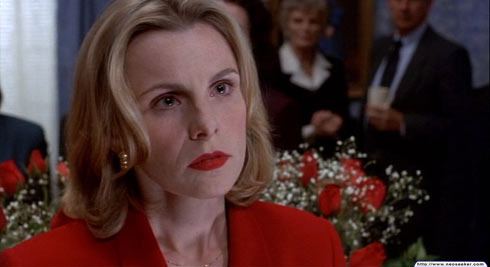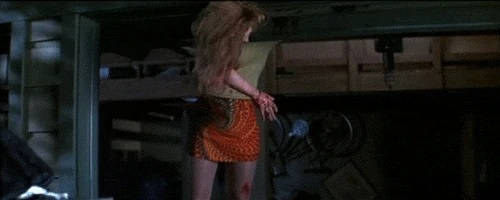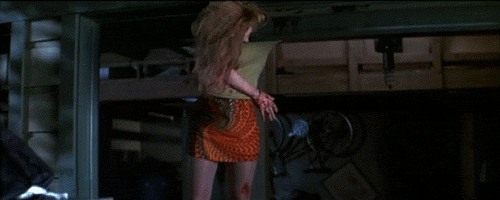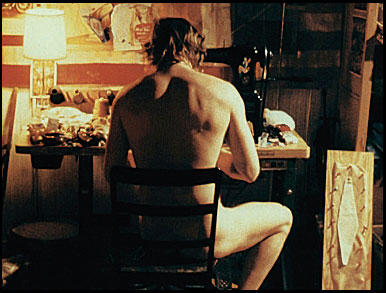In keeping with the times, M. Knight Shyamalan’s 1999 thriller The Sixth Sense, is a prime example of a typical 90s’ thriller. It relies on simplicity and the act of surprise, which can be seen in the shocking twist at the end of the film.
The film follows a young boy, Cole, who’s most famous line: “I see dead people,” will be repeated over and over again for generations to come. Cole has a sixth sense. He can see and talk to ghosts, which terrifies him. Unlike horror from the previous generations, depicting demonic babies, and possessed children, “the horror film has obliquely moved from the representation of children as terrors to children as terrorized”(Sobchack, Vivian, “Bringing it All Back Home”). The vulnerability of children makes it that much harder to watch as they repeatedly are haunted. Cole’s young age in the film makes the film more gut-wrenching as you watch the little boy quietly run from his bedroom to the bathroom because he is afraid, or jump into Mom’s bed in complete fear.

We watch on rooting for Cole as we see him mature and through the mentor-ship of, psychologist, Vincent, he learns to interact with the ghosts and to help them. The supernatural thriller humanizes the dead that Cole interacts with. Each ghost has a back story, a reason of why they come to Cole, making the movie so much more realistic and creepy. This humanization of the “bad guy” is typical of ’90s horror. Humanization of the bad thing and an emphasis on story line rather than on shock factor is typical of ’90s horror.
Cole communicates with the ghosts in an attempt to help them with their unfinished business on Earth, but the ghost that particularly stuck in my mind is that of a young girl named Kyra. Kyra’s relevance in the movie is particularly important for Cole finds purpose in his ability to see ghosts, but it is also important in the discussion of gender in The Sixth Sense.
Kyra visits Cole in his bedroom one night. The girl is very sick, and Cole wants to help. He finds wear she lived and goes to her house to attend her funeral. At the house Cole notices that Kyra’s younger sister has fallen sick with the same illness, and her father is shown in complete distress. Cole wanders into Kyra’s room where she leads him to a box of tapes, which reveal that the girls’ mother was poisoning them this whole time.
Cole is able to save the younger sister from her evil mother and reveal the truth about Kyra’s death. Cole works as a justice warrior for the dead. It’s important that this film, however, bring up something that is such a spectacle to most, that it is often only shown in horror films: a mother who kills her children because of jealousy. The mother clearly shows signs of Munchausen’s Syndrome by proxy.

More so than any jump scare, gaping wounds, or burned faces, this scene from the movie stuck in my memory. It is so unnatural for a mother to kill her offspring, which is what makes Kyra’s story so cringe-worthy. Mrs. Collins is the actual villain in Shymalan’s The Sixth Sense. The idea of a mother who kills is a truly terrifying one.
It is interesting as well to compare Mrs. Collins with the only other mother in the film: Cole’s mother. Cole is raised by his single mother. She is caring and loving and shows deep concern for her son throughout the film. This is a stark contrast with Mrs. Collins who is cynical and narcissistic. I think that the film may be doing something here in showing that the single mother is succeeding in her role as a mother, whereas the nuclear family is falling apart. I think that the movie puts mothers in a new kind of light. Films like The Others and The Babadook show dysfunctional single mothers. It is not uncommon to see single mothers kill in horror films. The “bad mother” is prevalent in horror, but especially is the “bad single mother” because it is assumed that the pressures of motherhood are too much for a woman to handle on her own. The disapproval and curiosity of single mothers by society is what turns these women into such spectacles in films. Rather than putting the single mother on display as a “bad mother,” however, Shyamalan points the finger at the “unnatural” nuclear family in an interesting turn of events.

The sixth sense repaints motherhood and shines a refreshing light on the single mother. The simplicity and almost realistic terror shown in the film reflects thrillers of the ’90s. The “bad guys” (the ghosts) are humanized and the film doesn’t set out to be too flashy.
Citations:
- https://www.google.com/search?q=the+sixth+sense&rlz=1CASMAE_enUS568US568&source=lnms&tbm=isch&sa=X&ved=0ahUKEwiSmcy_-evTAhWDxSYKHZO0DSkQ_AUICygC&biw=1366&bih=654#tbm=isch&q=the+sixth+sense+cole+and+mother&imgrc=_jGxogpj3ZaZZM:
- http://www.allposters.com/-sp/The-Sixth-Sense-Video-Release-Posters_i996252_.htm
- http://www.cinemablography.org/blog/inside-look-the-story-and-cast-of-the-sixth-sense
- http://villains.wikia.com/wiki/Mrs._Collins
- Clover, Carol J. “Her Body, Himself: Gender in the Slasher Film.” Representations, 20 (1987): 187-228.






























